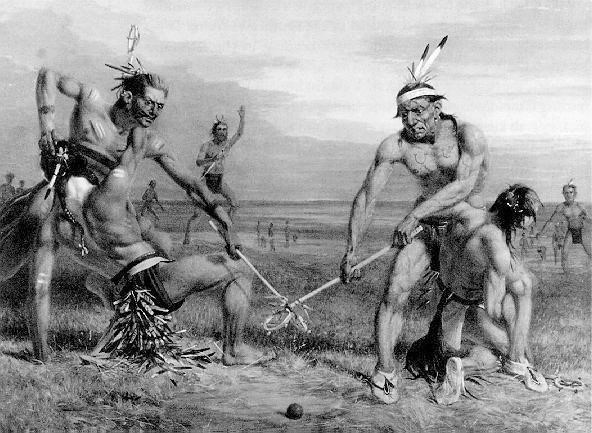Imagine running across a field. You’re tired and out of breath. You’ve been in what seems like an endless game. From sun up to sundown you’re running and fighting to make a goal. To some, it may seem like a game, but not to you. To you, it’s part of your culture, your religion, and, to you, the outcome matters.
Lacrosse was first played by Native American tribes in different regions of North America. There were many different versions of the game, rules, numbers of players, and sizes of the fields that would change depending on the tribe. Names of the game also varied, and included Creators’ Game, Baggataway, and Tewaaraton, which translates to “little brother of war.”1

The name that we know today as lacrosse came about in 1636 when French Missionary Jean de Brebeuf compared the shape of the sticks used by players of the game to a bishop’s crozier, which is ‘‘crosse’’ in French.2
For many Native American tribes, lacrosse wasn’t just a sport, but rather part of their culture and their religion. Since the game was very rough and people could be injured and even die while playing, the Iroquois used lacrosse as a way of training young men to be warriors, and the game was used to settle disputes without actually going to war. This is why lacrosse is nicknamed “little brother of war.”3 Lacrosse also had religious significance among some tribes. It was called the Creator’s Game, and it helped the players put their lives into perspective and teach lessons, some of the most valuable lessons being that everyone has struggles and opponents and the key to survival is friends and allies.
In the culture of the Iroquois, when a man dies, his lacrosse stick is buried with him. They believed that the first thing he would do when he wakes up in the afterlife is to take the stick from his coffin and begin playing that day.4

Native American lacrosse was often played on a stretch of land up to two miles long with sticks between 3-5 feet long made of wood and animal skin. A game could include between one-hundred to one-thousand players at a time. There was no set time to the games. The two teams would agree on a set amount of points and would play from sunrise to sunset until the amount of points was achieved.5 Violence and injuries were very common, and players would often walk away with minor cuts, broken bones, head injuries, and occasionally a death would occur.
Few people can claim to have experienced a Native American game of Lacrosse. Artist George Catlin had a passion for learning about Native Americans, and how they lived. He once said that “If my life is spared, nothing shall stop me short of visiting every nation of Indians on the Continent of North America.” He attended a major Choctaw lacrosse game in 1834. In his time there, he recorded everything that he saw and described how the game was set up from the length of the field and deciding where the goals would be places, to how each team was set up. He described how the night before the match both teams danced and chanted all night. Each team had a medicine man who chanted incantations to strengthen their team and weaken the other. He recorded his experiences through paintings and writings.6
Lacrosse is a sport that has a beautiful history and carries a meaning that many of us will never be able to understand. To Native Americans, lacrosse was a sport, a teaching tool, a religion, and a way to connect their cultures with other tribes.7 Today the history and meaning behind lacrosse has been lost, and to many it has become just another sport played for recreation and friendly competition.
- The Gale Encyclopedia of Fitness, 2012, s.v. ‘”Lacrosse,” by David E. Newton. ↵
- Salem Press Encyclopedia, 2017, s.v., “Lacrosse,” by Justin D. Garcia. ↵
- Thomas Vennum Jr., “American Indian Lacrosse: Little Brother of War,” The Journal of American Folklore 108, No. 427 (1995): 98-99. ↵
- S. L. Price, “Pride of a Nation,” Sports Illustrated 113, no. 2 (2010): 60-71. ↵
- Stanley A. Freed, “Lacrosse yesterday and today,” Cobblestone 15, no.9 (1994): 32. ↵
- Joanna Shaw-Eagle, “Catlin saves vanishing Indians on canvas,” The Washington Times, January 4, 2003. ↵
- John Seabrook, “Gathering of the Tribes,” New Yorker 74, No. 26, (August 1998): 30. ↵



154 comments
Grace Bell
This article was very entertaining to read. I really enjoyed learning about the history of lacrosse because lacrosse has always been an interesting sport to me. The fact that it was created by the Indians amazed me because I had always thought it had come from a European country, and they brought it to the Americas in their travels. Great job on this article!
Osman Rodriguez
This is a really cool and interesting article. I, not being a big fan of lacrosse, don’t know much about the sport. I find it very interesting that it’s origins came from the Native Americans. In a way lacrosse to the natives, is like football to Americans today. Of course, there is a greater purpose and significance for the natives. Still, I can not imagine playing from sunrise to sunset. Also, wouldn’t it be great if, as nations, we could settle disputes through sports?
Briana Myers
This was a very good article. I did not know a lot about lacrosse before reading this piece, so the history of it was very surprising to me. I cannot imagine having to watch a game where there are more than one hundred people actively playing at the same time. I think that it is very interesting that they would use lacrosse as a way to train the boys. I am sure that many of the people that play lacrosse do not have any idea about the history of this sport.
Abigale Carney
Very interesting article! I have never heard about the history of lacrosse before! This article was very informative, and provided many surprising facts about the history of lacrosse. It is cool to hear the history of sports and how they began! I would’ve never guessed that the Native Americans created the game of lacrosse. It is super interesting that the Native Americans used the game of lacrosse to train their men for battle, but it shows how competitive the game is when the Native Americans often died while playing the game. Very cool!
Rebekah Esquivel
This story was very interesting to me. Hearing a little about the history of lacrosse in one of my other classes a few weeks ago interested me, which is why I read this article. I find it amazing how it was not only a game for these Native Americans but a way a life and a part of their religion. I found it very interesting how men were buried with their lacrosse sticks in hope that they would be able to play in their after life. This was a very well written and interesting article.
Matthew Rios
A simple and well put together article. I never once thought of where Lacrosse had come from, and its origins baffle me. I had no idea Native Americans concocted this sport, but I wonder how it evolved to what it is today. Nowadays, it seems far less rough and gruesome sounding. I’m not sure if anyone really dies playing Lacrosse now.
Lauryn Hyde
Learning about the history of Lacrosse was very intriguing. It is interesting that a simple game that is still played today, less aggressive of course, is such an important role in the culture of Native Americans. It goes to show how important it is to their culture by the amount of competition and aggression they put into each game.
Soteria Banks
This story is very interesting, I didn’t know lacrosse had so much history behind it, the culture and meaning of it was powerful. Also it was a fun and strategic way to train the men. Battle and war is always so serious. I’m happy that this sport was passed down into our generation, although its not as popular as other sports which it should be. I also like the pictures and the attire. the feathers and color are very unique.
Evelin Joseph
I have never really been introduced to or researched Lacrosse before, so this article gave me a lot of knowledge and insight on the sport. It was cool to learn that, to Native Americans, lacrosse wasn’t simply a sport that they used to pass time, but a serious part of their culture in which people could even die. It helped them become better fighters and warriors that were ready for war. It helped them teach lessons and even was an integral part of their death. I was never before aware of the great significance of lacrosse in Native American culture, so this article truly taught me a lot.
Benjamin Voy
What a truly interesting background to a sport. In Scotland, we have something similar called “Shinty”, which can also turn very violent. Its crazy to think that a death in these sort of games was normalised and that it could be expected to come off the field with broken bones. I had no idea of the aged background to Lacrosse and this article really captured it well